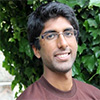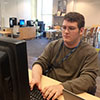By Mazin Gilbert and Igal Elbaz
Not all internships are equal. At our innovation centers, interns are an active part of our research and ideation. They provide valuable insight that helps turn concepts to reality.
This summer, AT&T Labs and Foundry welcomed interns from colleges across the nation to dream up new ideas, solve complex problems and bring products and services to the market.
They’ve spent the last couple of months working alongside some of the brightest minds in the industry to improve our customers’ lives at home, work and play. And before we say “see you later,” we wanted to share what a few had to say about their experience.
Why did you choose AT&T?

Bo Yan
Innovation Center: Labs, Bedminster, New Jersey
Research Area: Network Management
I’ve been working at AT&T each summer for 2 and a half years. During my first 2 years at NYU as a PhD student, I struggled to find a relationship between my research in network management and real problems. AT&T helped me do that.
I’m amazed how open AT&T is with its interns. They willingly share their resources – production information, problems they’re facing, etc. – and expose their concerns, so we can work together to solve problems. Other companies are more cautious about sharing resources. I really appreciate being able to apply my research in network management to real-world problems.
What was your summer experience at AT&T like?

Rajiv “Raj” Krishnakumar
Innovation Center: Foundry, Palo Alto, California
Research Area: Network Transformation, SDN, Consumer Services
My work at school and at the Foundry are both in quantum physics. But my work at the Foundry is theory and simulation based, which is a welcome change to the 6 years of experimental work I've been doing for my PhD.
This summer, I worked on the INQNET (INtelligent Quantum NEtworks and Technologies) project, translating the work in quantum computing, which mainly exists in academia, to something more scalable and practical for the industry. Specifically, I looked at how we can use quantum bits to improve machine learning algorithms.
Outside of my work, I learned a lot from a diverse group of people, ranging from specific domain knowledge, the differences between industry and academia, to life experiences and perspectives in general.
What did you enjoy most about your experience at AT&T?

Jami Jackson Mulgrave
Innovation Center: Labs, New York City
Research Area: Big Data Research
With her help, I had the guidance I needed to work on projects related to targeted TV advertising. We help advertisers who want to know more about the makeup of the advertisers’ household audiences, and also how to better predict the performance of advertising campaigns.
I enjoyed working with my mentor, Emily Dodwell. She was very supportive. She understood that with my background as a PhD student in statistics, I had a lot to learn about real data, which isn’t as clean as the datasets I’ve worked with in school.
What does a typical day look like for you?

Brendan Tschaen
Innovation Center: Labs, Bedminster, New Jersey
Research Area: SDN/Network
I usually meet with my mentors to discuss progress I’ve made and any problems I encounter. My mentors have real-world experience with the tools I’ve learned about in textbooks so learning from them is invaluable.
Beyond that, I set up a lot of experiments. These help us verify our claims and intuition about optimal software-defined network performance and efficiency.
The network is filled with hardware appliances. And now, we’re moving from hardware to software because we can develop and roll it out faster. I work on managing traffic during software upgrades of virtual network functions. I look at specific network functions – firewalls, proxy, routing – and explore techniques for redirecting traffic when the software on these network functions is updated. The goal here is preventing the customer from being disrupted during network congestion.
How do the projects you work on now compare to what you work on at school?

Harman Anand
Innovation Center: Foundry, Plano, Texas
Research Area: Software
I work on 2 projects. The first, Project Indigo, involves creating data-sharing communities. The second project creates standardized application interfaces so different software-defined networks can work with each other. This lets service providers around the globe work with AT&T’s network to provide SDN services to more people in more locations.
There is big difference between the projects I work on now and those at school. In school, projects are individualized, and we don’t talk to each other about them. At AT&T, I work in a team environment. I discuss with others how I want to tackle a certain problem, get advice on how to design something or get a fresh perspective when I am stuck.
What makes the work you’re doing “innovative?”

Daniel Barron
Innovation Center: Foundry, Plano, Texas
Research Area: Software
I work on the Indigo project, which is helping to make a more secure and convenient platform to share large sets of data among communities.
In today’s world, most companies keep their data to themselves, guarding it zealously. This makes sense because data is a big commodity now. Giving it away is no more helpful than showing everyone your hand at a poker table. You get nothing in return, and your competitors know exactly what you’ve got in store.
But great revelations lie inside these datasets. And there are certainly more interesting correlations and patterns hidden in their union. One of Indigo’s goals is to facilitate this collaboration.

Kush Khosla
Innovation Center: Foundry, Palo Alto, California
Research Area: Network Transformation, SDN, Consumer Services
Lots of artificial intelligence techniques – that were actually developed at AT&T – are just starting to be used thanks to an increase in computing power. Any application of these techniques to a modern day problem is innovative.
But the real innovation comes from the fact that AT&T is redefining how a network should operate with software. Combining these 2 opens up a plethora of new solutions to classic problems. I’m very excited to see our progress moving forward.